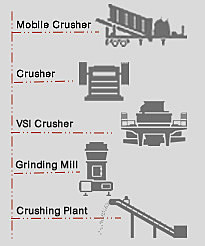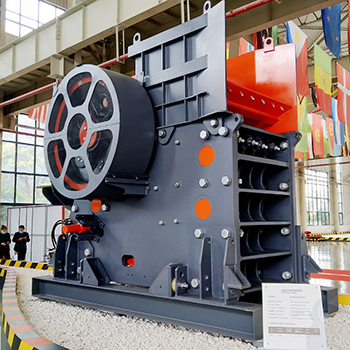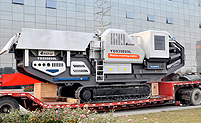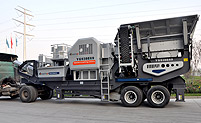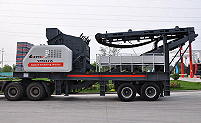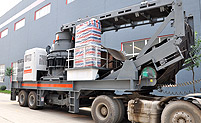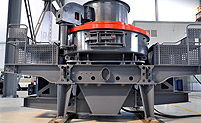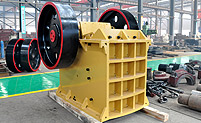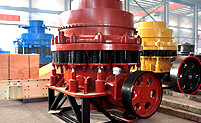Crushing process and equipment in the beneficiation process
Crushing process and equipment
Crushing is a process in which the particle size of bulk materials becomes smaller under the action of mechanical force. Crushing is an important part of the mineral processing process. Crushing can be divided into four stages: crushing, grinding, ultrafine grinding, and ultrafine grinding. The crushing process is an operation with high energy consumption, and the basic principle of the crushing process is "more crushing and less grinding".
Crushing process
(1) A crushing process. A crushing process is generally used to provide suitable feed materials for the autogenous mill, and often forms a system with the autogenous mill. The technological process is simple, the equipment is small, and the factory building occupies a small area.
(2) Two-stage crushing process. This process is mostly used by small factories.
(3) Three-stage crushing process. The basic form of the flow has three sections of open circuit and three sections of one closed circuit.
(4) Crushing process with ore washing operation. When the mud content (-3mm) of the feed material exceeds 5%~10% and the water content exceeds 5%~8%, the ore washing operation should be added in the crushing process.
Grinding and classification process
(1) Ball milling and rod milling process
For mineral processing, one-stage or two-stage grinding can economically grind ore to any particle size required for mineral processing. Grinding with more than two stages is usually determined by the stage separation requirements.
Compared with the one-stage and two-stage process, the main advantages of the one-stage grinding process are: less equipment, low investment, simple operation, and the shutdown of one grinding section will not affect the work of the other grinding section, and the loss of downtime is small. However, the range of feed particle size of the mill is wide, it is difficult to load the balls reasonably, it is not easy to obtain a finer final product, and the grinding efficiency is low. When the maximum particle size of the final product is required to be 0.2~0.15mm (ie 60%~79%-200 mesh), a one-stage grinding process is generally adopted. For small factories, in order to simplify the process and equipment configuration, when the grinding fineness is required to be 80%-200 mesh, a grinding process can also be used.
The outstanding advantage of two-stage grinding is that it can obtain finer products, and it can carry out coarse grinding and fine grinding in different grinding stages, which is especially suitable for stage treatment. In large and medium-sized factories, when the grinding fineness is required to be less than 0.15mm (that is, 80%-200 mesh), it is more economical to use two-stage grinding, and the product particle size composition is uniform, and the phenomenon of over-grinding is less. According to the connection between the first mill and the classifier, the two-stage grinding process can be divided into three types: the first stage is open; the second stage is fully closed; the first stage is partially closed, and the second stage is always closed. Grinding process.
(2) Self-grinding process
There are two types of autogenous grinding processes: dry grinding and wet grinding. Concentrators mostly use wet grinding. In order to solve the problem of hard-grinding particles in autogenous grinding and improve the grinding efficiency, a small amount of steel balls are added to the autogenous grinding machine, which is called semi-autogenous grinding.
Self-grinding often works in conjunction with crushing equipment such as fine crushing, ball milling, and pebble milling, and various technological processes can be formed according to its connection mode.
Crushing and screening equipment
There are many kinds of crushing equipment used in industry now, and there are many classification methods. Crushing equipment can be divided into: Jaw Crusher, Cone Crusher, Roller Crusher, Impact Crusher and Grinder etc. according to the working principle and structural features.
(1) Jaw Crusher
The crushing work of the jaw crusher is to periodically press the movable jaw plate to the fixed jaw plate to crush the material sandwiched between the two jaw plates. the
According to the trajectory of the movable jaw, it can be divided into simple swing jaw crusher and complex swing jaw crusher. The jaw crusher, commonly known as "Tiger's Mouth", is one of the crushers with a long history and is still the most effective equipment for crushing hard materials.
(2) Cone Crusher
The cone crusher uses the conical surface of the rotary pendulum movement to periodically approach the fixed cone surface, so that the product material sandwiched between the two cone surfaces is squeezed and bent to be crushed. It can be divided into gyratory crushers for coarse crushing and cone crushers for medium and fine crushing.
(3) Roller Crusher
The working part of the roller crusher is two relatively rotating rollers. The surface of the roller can have teeth, which is called a toothed roller crusher. It is dominated by splitting and crushing and crushing. According to the number of toothed rollers, it can be divided into single-toothed roller, double-toothed and multi-toothed roller crushing machines.
(4) Impact crusher
Both hammer crusher and impact crusher are impact crushers. This kind of crusher has a high-speed rotating rotor with an impact hammer on it. When the material enters the crusher, it is crushed by the high-speed rotating hammer or gets energy from the high-speed rotating rotor, and is thrown to the crusher wall or ad hoc at high speed. The hard board was crushed.
(5) grinder
The grinder is a hollow cylinder with hollow journals at both ends, the material enters from one end of the cylinder, and the product is discharged from the other end. Grinding media (steel balls, steel rods or gravels) are installed in the cylinder. According to the different grinding media, the grinding machine is divided into ball mill, rod mill or pebble mill. When the cylinder rotates, the medium is brought to a certain height and falls, which will impact and grind the material to make the material crushed. the
The process of dividing mixed materials with different particle sizes into several different particle size levels through single-layer or multi-layer sieves is called sieving. Screening equipment includes fixed sieves, inertial vibrating screens, self-centering vibrating screens, heavy-duty vibrating screens, resonance sieves, and linear vibrating screens.
(1) Fixed sieve
The fixed screen is composed of steel bars or steel bars arranged in parallel. The steel bars and steel bars are called grid bars. The grid bars are connected together by cross bars. The size of the gap between the grid bars is the size of the screen hole. There are two types of fixed sieves: grid sieve and bar sieve.
(2) Inertia vibrating screen
Vibrating sieve is a kind of sieve commonly used in the industry, with a wide range of applications, suitable for pre- and inspection screening of medium and fine crushing. According to the characteristics of the motion track of the screen frame, it can be divided into two types: circular motion vibrating screen and linear vibrating screen. The former includes single-axis inertial vibrating screens, self-centering vibrating screens and heavy-duty vibrating screens; the latter includes dual-axis inertial vibrating screens and resonant screens, and can be divided into single-layer screens and double-layer screens according to the number of screen layers.
(3) Self-centered vibrating screen
The self-centering vibrating screen is suitable for screening medium and fine-grained materials in large and medium-sized factories. The model of the domestic self-setting center screen is SZZ, which is divided into SZZ1 (single layer) and SZZ2 (double layer) according to the number of screen layers. Generally, it is a hanging screen, but there are also seat screens.
(4) Heavy vibrating screen
The principle of the heavy-duty vibrating screen is similar to that of the self-centering vibrating screen, but the main shaft of the vibrator is not eccentric at all, and the shaft hole of the pulley is eccentric to achieve the purpose of self-centering during operation. The heavy-duty vibrating screen has a relatively strong structure and can withstand large impact loads. It is suitable for screening bulky and high-density materials, and the maximum feeding can reach 350mm. It is mainly used for pre-screening before secondary crushing. In addition, for materials with high water content and high mud content, pre-screening and ore washing can be carried out before secondary crushing. mud system.
(5) Resonance screen
Resonant screen is also called elastic connecting rod type vibrating screen, which has large vibration amplitude, high screening efficiency, large processing capacity, low power consumption and compact structure. However, the manufacturing process is complicated, the machine has a large mass, the amplitude is difficult to stabilize, the adjustment is more complicated, and the rubber spring is easy to age.
(6) Linear vibrating screen
The linear vibrating screen has large vibration force, large amplitude, strong vibration, high screening efficiency, high productivity, and can screen coarse materials. Due to the horizontal installation, the installation height is small, and the linear reciprocating motion is beneficial to dehydration, desliming and heavy medium beneficiation. However, the structure is relatively complicated, and the rotation speed of the two shafts is high, so the requirements for manufacturing and lubrication are high, and the vibration is not easy to adjust.
Grinding and classifying equipment
The widely used grinding equipment in mineral processing plant is ball mill and rod mill. In the ball mill, only grid type and overflow type are used at present. Because of its low productivity, conical ball mills are no longer manufactured, but some old concentrators are still in use. The specifications of ball mills and rod mills are expressed in simplified inner diameter D and barrel length L.
(1) Grid type ball mill
The structure of the various specifications of the ball mill is basically the same. The cylinder of the ball mill is rolled and welded with a steel plate with a thickness of about 18-36 mm. Its two ends are welded with cast steel flanges. The cylinder is equipped with a liner. It is made of materials such as manganese steel, chrome steel, wear-resistant cast iron or rubber, among which high manganese steel is widely used, and the use of rubber is still in the trial production stage. The thickness of the liner is about 50-130 mm, and there is a gap of 10-14 mm between the shell and the shell. Plywood, asbestos pads, or plastic poles or rubber are laid in it to slow down the impact of steel balls on the cylinder.
(2) Overflow ball mill
The overflow type ball mill does not need to install a heavy grid plate because the ore discharge depends on the ore paddle itself being higher than the lower edge of the hollow shaft to overflow by itself. In addition, in order to prevent small balls and coarse-grained ore lumps from being discharged together with the pulp in the ball mill, anti-helical blades are inlaid on the inner surface of the hollow journal bushing.
(3) Rod mill
At present, there are only two types of rod mills used in concentrators: overflow type and open type. The former is more commonly used, and the latter has been discontinued. The structure of the rod mill is roughly the same as that of the overflow ball mill. The grinding medium used is a long round rod.
(4) centrifugal mill
Centrifugal mill is a new type of high-efficiency ultra-fine equipment, which is divided into two types: vertical and horizontal. According to the number of tubes, the former can be divided into single-tube and three-tube (planetary) centrifugal mills.
(5) Vibrating grinding machine
The vibrating mill works at high frequency, and high-frequency vibration is easy to cause cracks in the material, and can generate a relatively high stress concentration in the cracks, so it can effectively perform ultra-fine grinding. However, the spring of this kind of machine is easy to be damaged due to fatigue, and the consumption of the liner is also large. 5 microns (dry grinding) or 5-0.1 microns (wet grinding). .
(6) jet mill
Jet mill is a new type of dry grinding equipment that integrates fine grinding, grading, drying and other operations of materials. It is mainly used in the chemical and building materials industries, but recently there is a tendency for it to be used for grinding. The working condition of the jet mill is: use high-temperature compressed air, or superheated steam, or other preheated gases as the medium. Compared with ball mill and pebble mill, the grade of concentrate is about 2-3% higher and the recovery rate of iron is about 2-15% higher.
(7) Spiral classifier
The spiral classifier is the equipment matched with the wet ball mill to complete the grinding and classification together with the ball mill. Its specifications are represented by diameter, and can be divided into single-screw classifier and double-screw classifier according to the number of spirals. According to the height of the liquid separation surface, it can be divided into high weir type, submerged type and low weir type.
(8) Hydrocyclone
The upper part of the hydrocyclone is cylindrical, the lower part is conical, an overflow pipe is inserted in the center of the cylinder, and there is a slurry inlet pipe tangent to it outside the upper part. Hydrocyclones have been used in mineral processing plants in my country for many years, and are mainly used for fine-grained classification, pulp concentration, desliming and dehydration, etc.
NEXT: Experts explain how to configure the sand making machine production line

